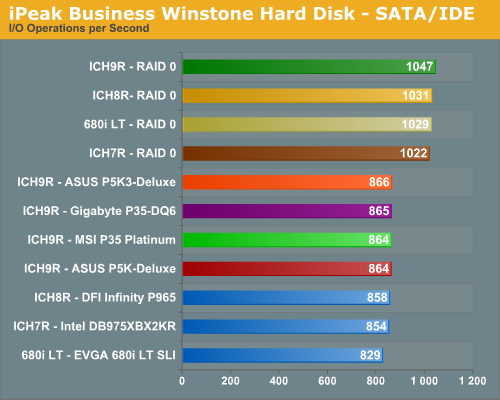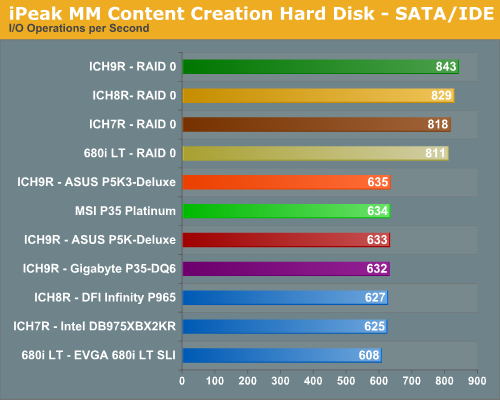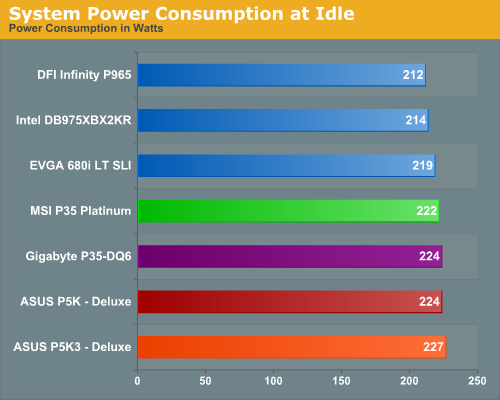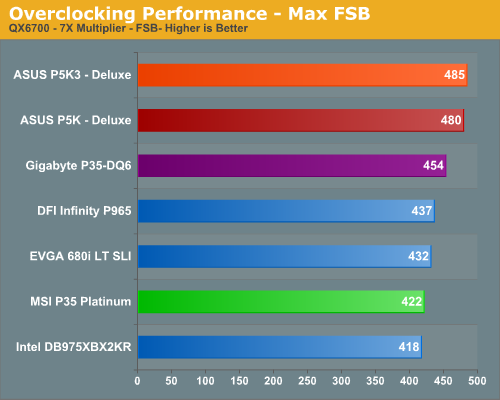Intel P35: Intel's Mainstream Chipset Grows Up
by Gary Key & Wesley Fink on May 21, 2007 3:45 PM EST- Posted in
- CPUs
Disk Controller Performance
The AnandTech iPeak test is designed to measure "pure" hard disk controller performance, and in this case we keep the hard drive as consistent as possible while varying the hard drive controller. The idea is to measure the performance of each hard drive controller with the same hard drive. We report the scores as an average number of I/O operations per second so that higher scores translate into better performance. This number is somewhat meaningless as far as hard disk performance is concerned; however, the scores are useful for comparing "pure" performance of the storage controllers in this case. Results are taken from trace files of Winstones 2004. Due to compatibility issues with Vista, our IPEAK tests are run on Windows XP SP2.

The performance patterns hold steady across both Multimedia Content I/O and Business I/O with the ICH9R outperforming the Intel ICH7R, Intel ICH8R, and NVIDIA 680i chipsets in our tests. Intel told us we should see up to a 4% difference between the ICH9 and ICH8; while our tests do not reveal that, we have noticed a difference in actual usage within Vista, especially when transferring large files. We will have Vista specific tests in the near future. Although our NVIDIA boards generally score lower in these "pure" throughput tests, we find their actual performance in disk intensive applications are generally equal to other solutions during actual usage. We did not experience any RAID 0 issues with the NV controller or drivers under Vista during normal usage but users have reported their RAID arrays degrading over time. We are still investigating these issues.
Power Consumption
As always, we measured power consumption at two states: at idle sitting at the Vista desktop and under load while running our 3DMark06 and Company of Heroes benchmarks. At both settings, EIST/C1E were disabled to show power usage with the system in a normal desktop state.


The surprise is that despite a 16W TDP, the P35 boards actually consume more power than the other chipsets at both idle and load. Even though the DDR3 board has a lower power rating for the memory, it consumes more power than the DDR2 board due to additional circuitry . We can no longer say that NVIDIA is the only high performance chipset approved by OPEC.
FSB Overclocking

Our FSB overclocking results are limited to the quad core QX6700 for this article. We will greatly expand our overclocking results for the roundup that will include five different CPUs. Our ASUS boards overclock the quad core the best at this time thanks to a fairly mature BIOS and great board design. Our Gigabyte and MSI boards have improved greatly over the last week with new BIOS designs and we expect overclocking to improve before the official launch date. In limited testing with the E6600, we were able to hit a 576 FSB on the ASUS boards, 514 on the Gigabyte board, and 508 on the MSI board with the latest BIOS releases.










58 Comments
View All Comments
Comdrpopnfresh - Tuesday, May 22, 2007 - link
The power could be attributed to the DDR3. With it not being so mature there may be a lot of signaling going on that isn't necessary. Also- with all the new technologies, these boards simply have more going on on them. With more transistors on a cpu its is expected they will use more power- more connections and circuits on a board would mean the same. Everything is running faster too. The power consumption doesn't make sense given the lack of matching real-world performance enhancements, but as the article makes good sense in pointing out, Bios are a big contributing factor here.TA152H - Tuesday, May 22, 2007 - link
Except they ran the power tests with DDR2 on P35 based machines as well, and they were higher than P965 with the same memory. So, obviously, that isn't the cause in this instance.Gary Key - Tuesday, May 22, 2007 - link
After speaking with the board manufacturers and Intel, our original thoughts (briefings/white paper review) were confirmed that the additional circuitry required on the P35 DDR3 boards and in the MCH result in the increased power consumption on the DDR3 platform compared to the DDR2 platform. This holds true for the P35 DDR2 boards when compared to the DDR2 P965, the additional DDR3 circuity/instruction set is still active even though it is not being used. This is why you will see the DDR2/DDR3 combo boards shortly. However, the BIOS engineers believe that can work a little magic with the SpeedStep and C1E wait states to reduce power consumption, however we are talking just a few watts at best. More on this subject in the roundup, at least we hope we will have more... ;)TA152H - Tuesday, May 22, 2007 - link
Gary,Thanks, it's useful to know. Are they going to shackle the x38 with DDR2 support too?
Just confirms my earlier opinion, they should have gotten rid of DDR2 support. Intel is an interesting company, they can come out with a great product like the Core 2, and then have some monkey decide to include DDR2 and DDR3 on the P35. You never know if they'll have a clue, or not. I guess it's a good thing they make turkeys like this and the P7, otherwise we wouldn't have AMD. Although AMD might be the cause of this.
The monkey that decided to do this probably thought, "Oh, look what we can do that AMD can't". It seems to me they did that with the P7, a technological marvel way beyond AMD's capability to design, thank goodness, and the groundbreaking Itanium. Except neither one worked great. AMD's pragmatism has paid off nicely, and even though they can't realistically support DDR2 and DDR3 on the same motherboard, I don't think they really care. Of course, I'm just guessing, when a company does something this stupid, it's always difficult to understand why they did it. It would have been so simple to just have DDR3 support for the P35, and let the P965 handle the DDR2 crowd. It's perfectly adequate.
Thanks again for the information. It's disappointing, but with Intel you get used to it. They can't do everything right after all, and still be Intel.
strikeback03 - Wednesday, May 23, 2007 - link
There might be a more practical reason, such as lack of production capability for DDR3 or HP and Dell threatening to use VIA chipsets instead of P35 in order to keep using DDR2 and keep their prices competitive. I doubt consumers would like their prices increasing by a few hundred dollars for no noticeable performance improvement. And if they only keep the computer 3 or 4 years they will probably spend less on energy than on that DDR3.Who knows about X38, I'd guess DDR2 support won't disappear until the chipset revision for Nehalem.
TA152H - Wednesday, May 23, 2007 - link
Well, I agree if P35 were the only choice from Intel, this would be the case, but again, would you buy VIA if you could get a P965? I wouldn't. If the P965 were a lousy, and seriously obsolete chipset, yes, sure, you'd have to come out with something that replaced it. But they could have easily validated it for FSB of 1333, and at the point the only thing really new in the P35 would be the DDR3 support. So, why would you need it?I was going to get the P35 rather than the x38 because I figure x38 will be even more of a power hog considering the, to me, useless features it has. I don't plan on getting two high-end video cards, and I don't think I will run anything that requires twice the performance of the current PCI-E, but if they drop the DDR2 support, it might the one to go after. If you ever look at an Athlon 64 CPU, you can see the memory controller is simply enormous, so dropping it on the x38 could be significant. With it being high end, they may decide DDR2 isn't a high end technology so they drop it. I hope so.
JarredWalton - Monday, May 21, 2007 - link
Could be the Vista factor? I dunno what else to think about the power numbers.XcomCheetah - Wednesday, May 23, 2007 - link
Could you do a little testing on it... why so high power numbers..Secondly if i remember correctly the power number difference between 680i and P965 chipsets was greater than 20W.. but in your current tests the difference is pretty small.? So any guess what has caused this positive change.?
Reference
http://www.anandtech.com/cpuchipsets/showdoc.aspx?...">http://www.anandtech.com/cpuchipsets/showdoc.aspx?...
http://www.xbitlabs.com/articles/chipsets/display/...">http://www.xbitlabs.com/articles/chipsets/display/...
current power numbers on Anandtech
http://www.anandtech.com/cpuchipsets/showdoc.aspx?...">http://www.anandtech.com/cpuchipsets/showdoc.aspx?...